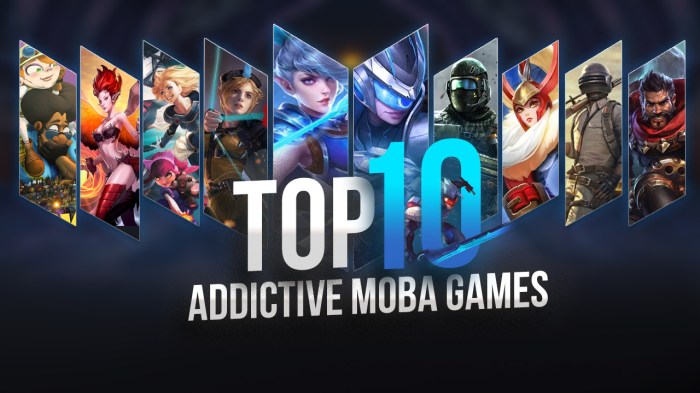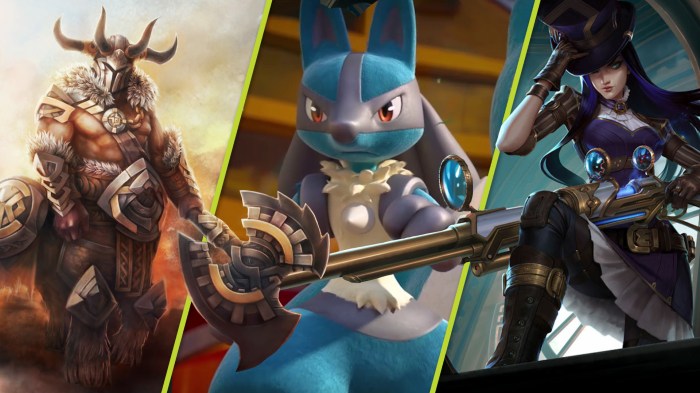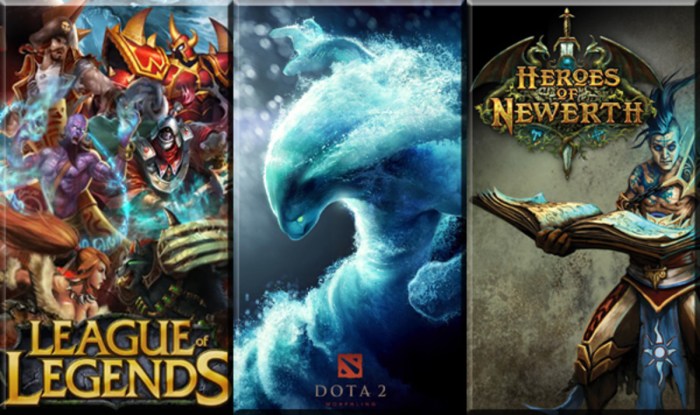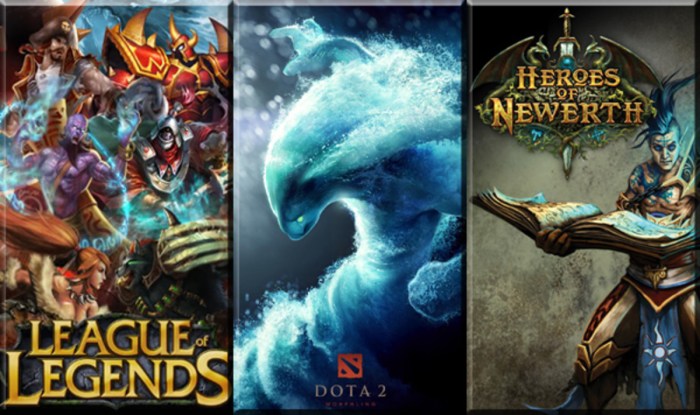MOBA games, short for Multiplayer Online Battle Arenas, have exploded in popularity, captivating millions with their blend of strategy, teamwork, and intense competition. From their humble beginnings as Warcraft III custom maps, MOBAs have evolved into a global phenomenon, spawning massive esports scenes and captivating game designs. This exploration dives into the core mechanics, economic systems, competitive landscapes, social dynamics, and technical underpinnings that define the world of MOBA games.
We’ll cover everything from the fundamental gameplay of controlling a hero and destroying enemy structures, to the complex strategies employed by professional players. We’ll examine the various monetization models, the impact of esports, and the unique community that has grown around these games. Get ready to level up your understanding of the MOBA universe!
Defining MOBA Games

MOBAs, or Multiplayer Online Battle Arenas, are a genre of video games characterized by their team-based competitive gameplay. Think of it as a digital version of chess, but with more action, more characters, and a whole lot more chaos. They’ve exploded in popularity over the last decade, becoming a major force in the esports world and influencing the design of countless other games.Core Gameplay Mechanics of MOBA Games involve two teams battling to destroy the opposing team’s base.
This is achieved by controlling characters with unique abilities and working strategically with teammates. Players typically control a single character, or “hero,” and level them up throughout the match, gaining access to stronger abilities and items. The map is usually divided into lanes, offering different routes to the enemy base and strategic choke points for battles. The gameplay is dynamic, constantly shifting based on team compositions, player skill, and unexpected events.
Historical Overview of MOBA Games
The roots of MOBAs can be traced back to the 1997 game
- StarCraft*, specifically the custom maps created by its players. One notable example is
- Aeon of Strife*, a custom map for
- StarCraft* that introduced many core MOBA elements, including lanes, towers, and heroes with unique abilities.
- Defense of the Ancients* (DotA), a custom map for
- Warcraft III*, built upon this foundation and significantly increased the game’s complexity and popularity, effectively laying the groundwork for the modern MOBA. From DotA, independent developers and larger companies alike created standalone MOBA titles, leading to the genre’s current widespread popularity. The evolution from custom maps to full-fledged games showcases the organic growth and community involvement integral to the MOBA genre.
Examples of Popular MOBA Game Franchises and Their Unique Features
Several franchises have risen to prominence in the MOBA world, each offering a unique twist on the core gameplay.
- League of Legends* (LoL), developed by Riot Games, is arguably the most successful MOBA globally, boasting a massive player base and a highly competitive esports scene. Its emphasis on strategic team composition and precise execution is a key differentiator.
- Dota 2*, a direct descendant of the original DotA, developed by Valve, is known for its complex mechanics, high skill ceiling, and intense competitive matches. Its heroes are exceptionally diverse, each possessing a unique playstyle and skill set.
- Smite*, developed by Hi-Rez Studios, distinguishes itself through its third-person perspective, offering a more visceral and action-oriented experience. This change in camera angle provides a different feel compared to the top-down perspective of many other MOBAs.
Different Roles and Character Types Commonly Found in MOBAs
MOBAs typically feature a diverse roster of characters, each designed to fill a specific role within the team. Common roles include: Tanks, who absorb damage and protect allies; Supports, who enhance their team’s abilities and provide crucial utility; Mages, who deal significant magical damage from a distance; Marksmen, who deal high physical damage from a distance; and Assassins, who excel at eliminating high-value targets quickly.
These roles are not always strictly defined, and some characters may blend aspects of multiple roles, adding to the strategic depth of team composition.
Comparison of Popular MOBA Games
| Game | Map Size | Number of Players | Gameplay Pace |
|---|---|---|---|
| League of Legends | Relatively Small | 5v5 | Moderate |
| Dota 2 | Large | 5v5 | Slow to Moderate |
| Smite | Moderate | 5v5 | Fast |
Competitive Aspects of MOBAs: MOBA Games

MOBAs, at their core, are intensely competitive games. Success hinges not just on individual skill, but on the seamless integration of individual talents within a coordinated team. The strategic depth, constant evolution, and thriving esports scene all contribute to the compelling competitive landscape of these games.
Teamwork and Coordination in MOBAs
Effective teamwork is paramount in MOBAs. Each role—from the tank absorbing damage to the carry dealing significant damage—plays a crucial part in a team’s overall strategy. Successful teams exhibit exceptional communication, utilizing voice chat or in-game pings to coordinate actions, share information about enemy movements, and plan objectives. Poor communication and a lack of coordination often lead to disorganized pushes, failed team fights, and ultimately, defeat.
For example, a coordinated team will use their abilities simultaneously to maximize damage output during a crucial team fight, while an uncoordinated team will likely waste their abilities individually, resulting in a less effective outcome.
Strategic Decision-Making in Professional MOBA Matches, MOBA games
Professional MOBA matches showcase the pinnacle of strategic thinking. Teams meticulously analyze their opponents’ strategies, adapting their own draft picks and in-game decisions accordingly. This includes map awareness, efficient resource management (gold and experience), and objective control (towers, dragons, etc.). A prime example would be a professional team strategically choosing to sacrifice a tower to secure a crucial buff that provides a significant advantage in a later team fight.
These high-level decisions often hinge on subtle nuances and quick reactions to changing in-game dynamics.
Meta-Game Strategies and Their Evolution
The “meta,” or meta-game, refers to the prevailing strategies and champion choices that dominate the competitive landscape at a given time. The meta is constantly evolving, influenced by game patches, community innovation, and professional play. For example, a new champion might be released, dramatically altering the meta by becoming a dominant force, forcing teams to adjust their strategies to either counter or utilize this new champion effectively.
This constant evolution keeps the game fresh and engaging, requiring players to adapt and learn continuously.
Competitive Leagues and Tournaments for League of Legends
| League/Tournament | Region | Frequency | Prize Pool (USD, approximate) |
|---|---|---|---|
| League of Legends Championship Series (LCS) | North America, Europe | Spring & Summer Splits annually | Millions |
| League of Legends Pro League (LPL) | China | Spring & Summer Splits annually | Millions |
| League of Legends Champions Korea (LCK) | South Korea | Spring & Summer Splits annually | Millions |
| World Championship (Worlds) | Global | Annually | Tens of Millions |
Esports’ Impact on MOBA Popularity and Growth
The rise of esports has been instrumental in boosting the popularity and growth of MOBAs. High-stakes tournaments, streamed to millions of viewers worldwide, have created a captivating spectacle. Professional players have become celebrities, inspiring aspiring gamers and driving further engagement with the game. The significant prize pools and sponsorship deals associated with professional MOBA competitions further incentivize participation and development within the ecosystem, ensuring a continuous cycle of growth and innovation.
Social and Community Aspects

MOBAs, by their very nature, are intensely social games. The constant need for teamwork, coordination, and communication creates a vibrant and often complex community. This community, however, is a double-edged sword, offering both incredible camaraderie and frustrating toxicity. Understanding the dynamics of this community is crucial to enjoying the MOBA experience.The social aspects of MOBAs extend far beyond the in-game interactions.
Players forge bonds through shared victories and defeats, building relationships that often transcend the digital realm. The competitive nature of the game fuels both friendly rivalries and deep friendships, creating a sense of belonging that many players find incredibly rewarding. This sense of community is actively cultivated and sometimes exploited by the game developers themselves through events, rewards, and social features.
Communication Tools and Platforms
MOBAs rely heavily on effective communication. In-game chat, both text and voice, is essential for coordinating strategies, calling out enemy movements, and generally keeping the team on the same page. Beyond the game itself, players often use third-party platforms like Discord and TeamSpeak to communicate before, during, and after matches. These platforms allow for more in-depth strategic discussions and the development of stronger team bonds.
Social media sites like Twitter and Reddit also play a significant role, providing spaces for players to share highlights, discuss strategies, and engage in broader community discussions. Many professional teams also utilize these platforms for fan engagement and team announcements.
The Role of Guilds or Clans
Guilds or clans are integral to the MOBA experience for many players. These organized groups provide a framework for teamwork and collaboration, offering a structured environment for coordinated gameplay. Members often participate in guild-organized tournaments or events, fostering a sense of shared purpose and accomplishment. Guilds can also serve as a valuable resource for learning and improvement, with experienced players mentoring newer members.
Beyond the competitive aspect, guilds frequently serve as social hubs, providing a place for players to connect and socialize outside of the game itself. Strong guilds are often characterized by effective leadership, clear communication channels, and a supportive environment.
Methods of Encouraging Social Interaction
MOBAs employ several design features to encourage social interaction. The inherent team-based nature of the game necessitates communication and collaboration. In-game rewards, such as achievements and cosmetic items, often incentivize teamwork and participation in group activities. Ranked modes and competitive ladders further encourage social interaction by providing a framework for players to compete and collaborate within a structured environment.
Many MOBAs also incorporate social features such as friend lists, guilds, and in-game messaging systems, explicitly designed to facilitate communication and interaction between players. Events and seasonal content frequently add further layers of social engagement, creating opportunities for players to work together towards shared goals.
Positive and Negative Aspects of the MOBA Community
The MOBA community, like any large online community, presents both positive and negative aspects.
- Positive Aspects: Supportive and helpful communities, strong sense of camaraderie and teamwork, opportunities for skill development and improvement, a vibrant and engaging social scene, readily available resources and information.
- Negative Aspects: High incidence of toxicity and negative behavior, potential for harassment and abuse, elitism and gatekeeping, overwhelming amount of information and conflicting strategies, potential for addiction and excessive time commitment.
Key Questions Answered
What does “lane” mean in a MOBA?
In MOBAs, lanes are the paths leading from your base to the enemy base. Teams typically split up and control these lanes to push forward and attack enemy towers.
What’s a “meta” in MOBA games?
The “meta” refers to the currently most effective strategies and character combinations. It’s constantly evolving based on game patches and player experimentation.
How do I choose the right hero for me?
Consider your playstyle! Do you prefer dealing damage from afar, supporting your teammates, or engaging in close-quarters combat? Each hero has unique strengths and weaknesses.
Are MOBAs only for hardcore gamers?
Nope! While MOBAs have a high skill ceiling, they’re accessible to players of all skill levels. There’s always room to learn and improve.
